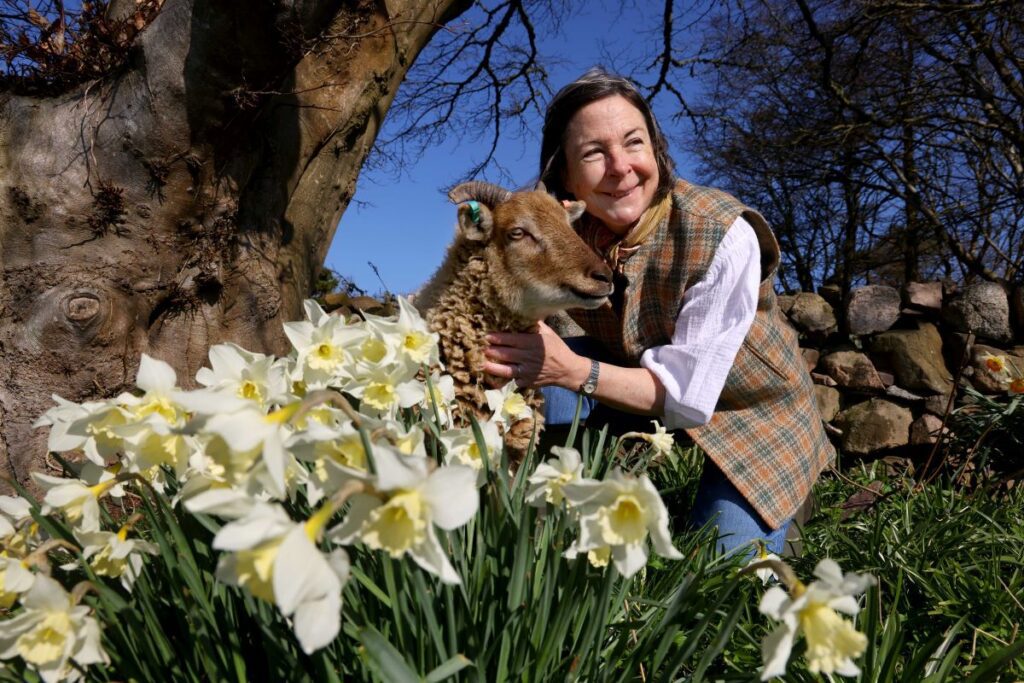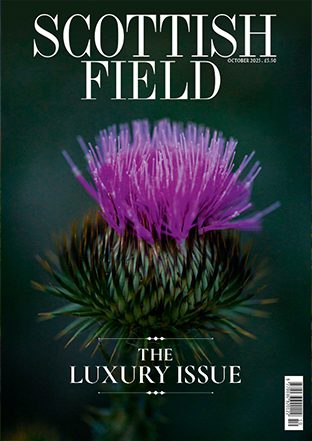
Meet the woman on a mission to help save a rare breed of Scottish sheep from extinction
Meet the woman on a mission to help save a rare breed of Scottish sheep from extinction – by turning their fleeces into woollen scarves.
Rebecca McLellan fell in love with the Castlemilk Moorit when she was looking for a breed in need of some champions.
She now has a small flock of 18 of the curvy horned, nimble brown sheep at her home in Rockcliffe on the Solway Firth.
In a bid to raise awareness of the endangered breed she hit on the idea of learning to weave.
‘They are a lovely breed, everyone who meets a Castlemilk Moorit is charmed, but they are rare and we really need more people to keep them to save them for the future,’ she said.
‘I realised that learning to weave would mean that I could do demonstrations where I could meet members of the public and talk to them about the sheep.
‘At the same time I could show that they are a useful breed, that their wool can be used to make beautiful textiles.’
Aside from looking beautiful with curving horns, neat legs and an antelope-like head, the sheep are practical.

‘Their fleece is dark at the base and pale cream at the tip – like Guiness,’ Rebecca said.
‘The wool can be used for a variety of purposes and their meat when enjoyed as hogget has a rich flavour.
‘A roasted leg or shoulder is the perfect size for up to six people to enjoy – so little waste for today’s modern families.
‘And as with all native breeds they have great characters and respond well to good shepherding, learning quickly with the odd bucket of sheep nuts to coax them along.’
The Moorits have a fascinating history, first bred in the 1920s by the Liberal politician, international trader and author of Hounds of the World Sir Jock Buchanan-Jardine.
The idea is that they would be an elegant addition to the parkland of his Castlemilk Estate and their high-quality wool could be used to clothe his workers.
Most were culled after his death in 1970, with just two rams and a few ewes being saved.
Rebecca is taking part in the Spring Fling open studios weekend which takes place across Dumfries and Galloway from 24-26 May, where she will be welcoming visitors to her farm overlooking Rockliffe Bay.
They will be able to see her working at the loom, visit the wool store, browse products including scarves, throws, knitting yarns and – of course – see the sheep, including Eddie the Orphan who she raised by hand.

‘The magic of Castlemilk fleece lies in its colour and texture,’ she said.
‘Not only is the fibre soft, supple and strong, especially when combined with other fibres to stretch it further, but specifically it’s about the colour of the yarn, a rich mocha.
‘The resulting yarn once dyed reflects this consistent base note which ensures that the colours work well together.
‘By using a limited complementary palette of colours echoing countryside around the farm the result is harmonised, warm and very much in keeping with its heritage.’
And was weaving a difficult process to learn?
‘I started weaving a couple of years ago, beginning on a small rigid heddle loom about the size of an old-fashioned typewriter,’ Rebecca said.
‘On this simple frame I was able to weave with my knitting yarn and create a range of light-weight, narrow scarves in traditional plaid designs, with the odd tweak or variation to keep them unique.
‘In January this year I decided to up my game to a larger, more complex loom with eight shafts, enabling me to extend my designs into more complex stitch patterns.’
Rebeccsa said learning to weave as an adult was a challenge as she came to terms with making mistakes and being clumsy.
But when you are creating something original it is fantastically satisfying too, she says.
‘The creative spirit in me is less worried about the perfection of the weave technique, and I’ve fallen in love with the artistic opportunity to combine my yarns into decorative yet practical fabric,’ Rebecca said.

‘Along with the fleece from my flock I do buy CMM fleece from other known breeders in Scotland and England. This is enabling me to explore more opportunities as they emerge.
‘Whilst at Spring Fling I will be focusing on my weaving, however elsewhere in a barn visitors will be able to see the ‘in the grease’ fleece that is then sorted by hand to remove vegetation and other arisings.
‘These spoilt ends are bagged in old feed-sacks as an excellent, ready fertilised mulch for gardeners to put in raised beds or around vegetables as a natural slug repellent etc.
‘The cleaned and tidied fleece is then sent to mills to be blended and spun into yarn.
‘My work, as I see it, makes the link between hands-on farming of a special native sheep to the delivery of creative results – as products and as materials for others to also explore.
Saving Castlemilk Moorits and our other priority native breeds is very much a shared task, and many people at all points of the process are involved.’
Spring Fling will see more than 80 studios belonging to visual artists and craft makers of every kind open their doors to the public across the region.
Read more News stories here.
Subscribe to read the latest issue of Scottish Field.
TAGS

